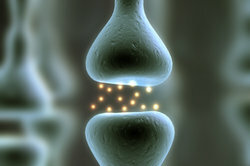How do synapses work?
Without synapses, the transmission of stimuli in the nervous system would not function. The synapse is where two nerve cells meet to transmit an impulse. But how exactly does it work?

This is how synapses are built
- Synapses are the places in the nervous system where two nerve cells meet or a nerve cell meets a target cell, for example a muscle or gland cell. A nerve cell consists of a cell body, the dendrites, which receive information, and the axon, which transmits the information. Synapses are where an axon meets a dendrite or a target cell.
- The synapse consists of the presynaptic membrane (on the presynaptic terminal head on the axon of the transmitting Nerve cell), the synaptic gap and the postsynaptic membrane (on the receiving nerve cell or other Target cell).
This is how the stimulus transmissions work
In order for the stimulus transmission to work, the stimulus has to jump over the synaptic gap.
- The transmission of stimuli along the feeding neuron works electrically. An electrical action potential "wanders" along the axon and reaches the presynaptic terminal head. When the action potential reaches the presynaptic terminal, there neurotransmitters are released into the synaptic cleft.
- These are then bound to receptors on the postsynaptic membrane, which changes the conductivity and creates a postsynaptic potential. The stimulus is passed on to the postsynaptic cell and then travels along it or, for example, causes the muscle cell to contract.
- So that this can work again and again, the neurotransmitters that are located in the synaptic gap and on the postsynaptic membrane are then broken down or broken down by enzymes. transported back to the terminal head, where they can be released back into the synaptic gap when a new action potential arrives.
- Important neurotransmitters are acetylcholine, norepinephrine, serotonin and dopamine. Neurotransmitters can either have a stimulating or inhibiting effect, i.e. they either trigger an action potential or reduce the excitability of the postsynaptic membrane.
For biology class or university, you need to know what the function of a ...
How helpful do you find this article?
The content of the pages of www.helpster.de was created with the greatest care and to the best of our knowledge and belief. However, no guarantee can be given for the correctness and completeness. For this reason, any liability for possible damage in connection with the use of the information offered is excluded. Information and articles must under no circumstances be viewed as a substitute for professional advice and / or treatment by trained and recognized doctors. The content of www.helpster.de cannot and must not be used to make independent diagnoses or to start treatments.

